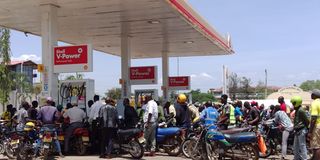Premium
Why Western, Nyanza, North Rift are hardest hit by biting shortage

Long queues at a Shell petrol station in Kisumu on April 4, 2022.
Kisumu, Kakamega, Eldoret and Bungoma are some of the hardest hit towns by the ongoing fuel shortage that has led to long queues at the few petrol stations still operating.
Motorists in the towns report being charged up to Sh240 per litre of fuel, nearly double the Sh134.72 price ceiling set by the Energy and Petroleum Regulatory Authority (Epra) last month. This has seen a rise in transport costs.
The effects will also be keenly felt on consumer prices as the cost of goods will go up, while activities such as farming are also set to be affected by the shortage of diesel.
Passengers were on Monday stranded in most towns in the North Rift after fares were doubled to between sh900 and Sh1,700 from Eldoret to Nairobi.
Limited amount
Many filling stations have also limited the amount of fuel that can be bought by a single customer to prevent bulk buying.
But why are towns in Western, Nyanza and parts of the Rift Valley so severely affected?
Petroleum Principal Secretary Andrew Kamau told the Nation yesterday that the acute shortage in the regions was due to cash-flow challenges faced by small oil marketing companies operating there.
He said bigger oil companies have for the past 20 years largely given the region a wide berth due to dumping of cheaper fuel meant for export in the regions. Kenya has about 2,762 fuel retail stations.
The oil firms, he said, transport fuel from Mombasa and Nairobi under the guise that it is headed for export but then dump it in the regions where it is sold cheaply.
“When the large oil marketing firms fled the regions, the space was taken over by small independent oil marketers who lack the financial muscle of the large firms,” said the PS.
“When fuel prices go up, the large oil companies have access to financing from banks which the small players do not have access to. This means they cannot afford new stocks when the prices sharply go up,” he explained.
Fuel subsidies
The situation has come out more clearly in recent days as queues of motorists in the towns continue to pile as consumers, many carrying jerry cans, flock to the remaining petrol stations that have fuel.
The shortage has been caused by delays by the government to pay Sh13 billion owed to oil marketing companies in fuel subsidies, which has seen them redirect their fuel stocks to the export market while others have opted to hoard them to avoid going into losses.
The large oil firms, who supply the small oil marketers with fuel, have also directed their outlets not to supply to the small firms, worsening the shortage.
The small firms have been forced to wait until they get paid the subsidy money by the government to enable them to replenish their fuel supplies.
In an interview with NTV on Sunday, Mr Kamau said the government will release the subsidy money to the oil marketers this week to end the fuel shortage crisis.
“It is about Sh13 billion [the amount of money owed to oil companies] which I suspect will be paid either by Monday or Tuesday,” said Mr Kamau.





